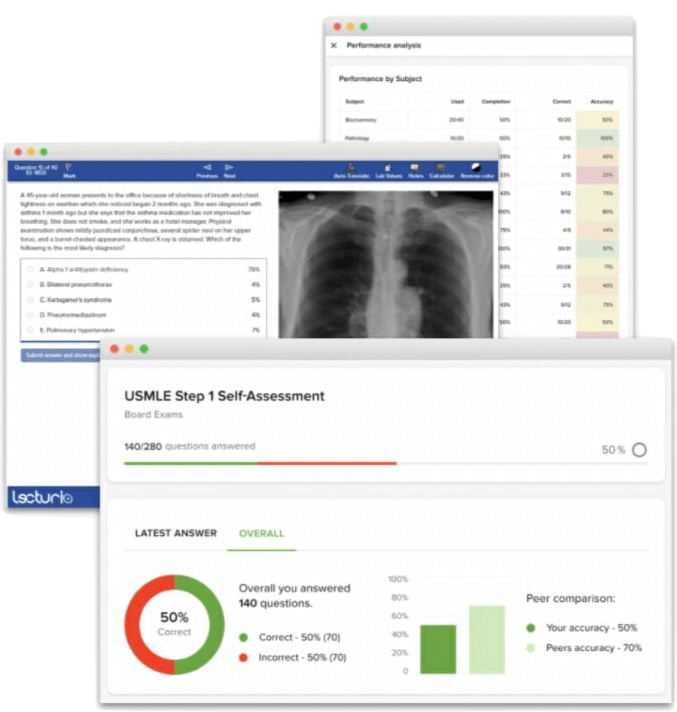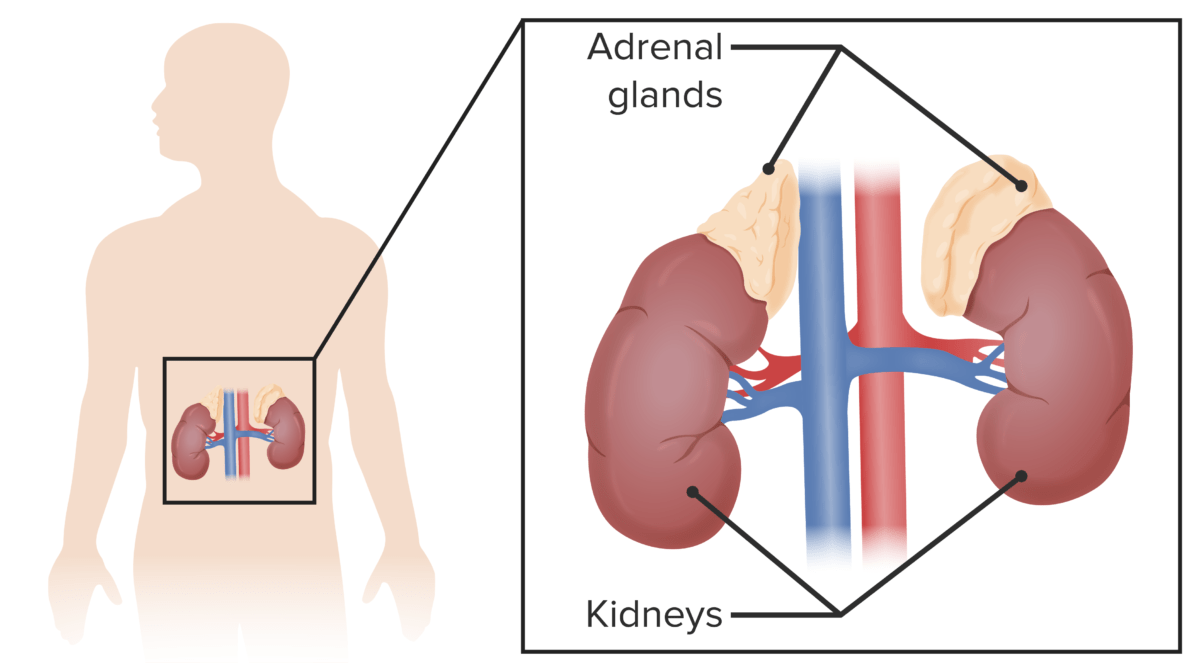These pathologies often present similarly, with jaundice or scleral icterus, yet normal liver function tests. KnowING how to spot the key differences to accurately diagnose these disorders is important both for boards and clinical practice.
First, grasping the different causes and types of hyperbilirubinemia will help you better understand these hepatic pathologies. Next, an overview of each syndrome will help you to understand the similarities and differences between the two. Lastly, a short comparison table will solidify key concepts that are the highest yield for testing these two syndromes.

What is hyperbilirubinemia?
Hyperbilirubinemia is defined as a serum or plasma bilirubin concentration above 1 mg/dl. It can be caused by various pathologies that start in different areas of the body. The physical manifestation of hyperbilirubinemia, jaundice (i.e., yellow discoloration of skin and sclera of eyes), becomes apparent at bilirubin levels greater than 2–3 mg/dl.
The causes of hyperbilirubinemia can be broken down into prehepatic pathologies, intrahepatic pathologies, or posthepatic pathologies.
- Prehepatic pathologies: due to increased red blood cell breakdown (hemolysis) and result in increased unconjugated (indirect) bilirubin
- Intrahepatic pathologies: due to impairments in hepatic uptake or defective bilirubin conjugation. These pathologies increase both conjugated (direct) and unconjugated (indirect) bilirubin.
- Posthepatic pathologies: due to reduction in bilirubin elimination via the biliary tract and increased reuptake of bilirubin. They result in increased conjugated (direct) bilirubin.
Conditions that cause hyperbilirubinemia can also be classified into those that result in predominantly unconjugated hyperbilirubinemia and those that cause an elevation in both conjugated and unconjugated forms of bilirubin.
Concise overview of hyperbilirubinemia of the newborn →
Rotor syndrome is an intrahepatic pathology resulting in mixed hyperbilirubinemia, an elevation in both conjugated and unconjugated bilirubin. Notably, in Rotor syndrome, conjugated bilirubin levels are often more significantly elevated. Dubin-Johnson syndrome is also an intrahepatic pathology, but specifically results in conjugated hyperbilirubinemia.
Overview of Dubin-Johnson syndrome
What is Dubin-Johnson syndrome?
Dubin-Johnson syndrome (DJS) is a rare inherited disorder of hyperbilirubinemia that is characterized by low-grade elevation of conjugated bilirubin and no other signs of liver injury. Patients often present with jaundice as their only clinical manifestation. DJS is benign, with no long-term sequelae, and does not require medical treatment. However, it is essential to properly diagnose DJS to eliminate the possibility of other hepatobiliary disorders that cause liver injury and require medical treatment.
Cause of DJS
Dubin-Johnson syndrome is an autosomal recessive disorder caused by a mutation in the ATP binding cassette subfamily C member (ABCC2) gene. This mutation results in the production of an abnormal protein called multidrug resistance protein 2 (MRP2) that works as a transporter protein in the liver. The mutation in the MRP2 gene causes impaired hepatocyte excretion of conjugated bilirubin into bile. Patients with Dubin-Johnson syndrome also have mild impairment in uptake.
Clinical signs and symptoms of DJS
- Physical examination is often normal in many patients with DJS. Most will be asymptomatic.
- Some patients will present with jaundice.
- Vague abdominal pain can occur in some patients.
- Hepatomegaly may be present in rare cases.
- Icterus can be so mild that it is only noted during intercurrent illness, pregnancy, or consumption of oral contraceptives.
- Onset is usually the second decade of life, but it can rarely present in infants.
- Although this disorder can occur in all races, nationalities, and sexes, it is more common in Sephardic Jews, where the incidence is approximately 1:3000. Testing companies sometimes will use this in a patient’s history, so this can clue you into Dubin-Johnson syndrome.
- Transmission is autosomal recessive, so a positive family history is occasionally obtained.
Lab and imaging findings of DJS
- Normal complete blood count (CBC)
- Normal liver function tests, including serum alanine aminotransferase (ALT), aspartate aminotransferase (AST), alkaline phosphatase (ALP), and gamma-glutamyl transpeptidase (GGT)
- Serum bilirubin concentrations are typically elevated, usually between 2 to 5 mg/dL. In rare instances, they can be as high as 20 to 50 mg/dL.
- Approximately 50% conjugated serum bilirubin
- Cholescintigraphy: delayed visualization or nonvisualization of the gallbladder and bile ducts in the presence of intense, homogeneous, and prolonged visualization of the liver
- Bromosulfophthalein clearance testing: After intravenous administration of plasma, bromosulfophthalein (BSP) clearance is delayed. Additionally, the concentration of BSP shows a secondary increase 90 minutes after administration. The secondary rise in BSP is due to a regurgitation of glutathione-conjugated BSP from hepatocytes into the plasma. The secondary rise is characteristic of DJS, but it is not diagnostic on its own.
- Bilirubin in the urine (bilirubinuria) is very common.
- The total urinary coproporphyrin is normal in DJS, but over 80% is coproporphyrin I. This contrasts with normal subjects with 75% urinary coproporphyrin as coproporphyrin III.
- 60% of patients with DJS will have a Clotting factor VII deficiency and reduced prothrombin activity.
Gross examination
- On gross examination the liver is darkly pigmented, or black.
- The liver is histologically normal except for the presence of dark pigment.
- Dark melanin-like pigment is in lysosomes.
Diagnosis
The diagnosis of Dubin-Johnson syndrome can be made by documenting conjugated hyperbilirubinemia (where at least 50% of the total bilirubin is the direct fraction). At the same time, the remainder of the liver function profile (serum alanine aminotransferase, aspartate aminotransferase, alkaline phosphatase, albumin, and prothrombin time) is normal. Additionally, patients must demonstrate characteristic urinary coproporphyrin excretion.
Treatment
Typically no treatment is needed, but choleretic agents (UDCA) can help reduce cholestasis in infants.
Overview of Rotor syndrome
What is Rotor syndrome?
Rotor syndrome is a rare inherited disorder that causes mixed direct (conjugated) and indirect (unconjugated) hyperbilirubinemia. This syndrome is characterized by non-hemolytic jaundice due to chronic elevation of predominantly conjugated bilirubin. Chronically elevated conjugated bilirubin occurs due to impaired hepatocellular storage of conjugated bilirubin that leaks into circulation, resulting in hyperbilirubinemia. The most common presentation of Rotor syndrome is jaundice. Overall, Rotor syndrome is a benign disease that does not require medical treatment.
Cause of Rotor syndrome
Rotor syndrome has an autosomal recessive inheritance, so patients may present with a family history of the disorder, similar to DJS. In Rotor syndrome, homozygous mutations in the SLCO1B1 and SLCO1B3 genes, which code for liver transporters, impair hepatic uptake and storage of conjugated bilirubin. The improper storage and uptake of bilirubin leads to bilirubin leakage into the plasma, resulting in hyperbilirubinemia.
Clinical signs and symptoms of Rotor syndrome
- Patients are often asymptomatic.
- Jaundice:
- Jaundice may be the primary presentation or could be incidentally discovered.
- May be intermittent
- Icterus may be present and can be the only clinical manifestation.
- No gender predisposition is seen with Rotor syndrome.
- Rotor syndrome begins shortly after birth or in childhood.
Lab and imaging findings of Rotor syndrome
- Normal CBC
- Normal liver function tests, including serum alkaline phosphatase, alanine aminotransferase, aspartate aminotransferase, and gamma-glutamyl transpeptidase
- Elevated bilirubin values, typically ranging from 2 mg/dL to 5 mg/dL
- Bromosulfophthalein (BSP) clearance testing: After intravenous administration of BSP, plasma clearance is delayed, with a 50% reduction in transport maximum. There is no secondary rise, unlike in DJS.
- Prolonged retention of intravenously injected unconjugated bilirubin and indocyanine green
- Cholescintigraphy: The hepatobiliary system will not be visualized.
- Bilirubin in urine (bilirubinuria) is common.
- The total urinary coproporphyrin excretion is increased to 250–500% of normal. Coproporphyrin I constitutes approximately 65% of urinary porphyrins.
Gross examination
- Liver is histologically normal.
- Although the absence of dark pigmentation differentiates Rotor syndrome from DJS, a liver biopsy is not required for differentiation and diagnosis.
Diagnosis
Rotor syndrome is often a diagnosis of exclusion. The laboratory and testing findings of elevated total serum bilirubin, BSP clearance testing, and cholescintigraphy can all help to confirm the diagnosis. The most important indicator of Rotor syndrome is elevated urine coproporphyrin excretion, which can differentiate this syndrome from DJS.
Treatment
Rotor syndrome is a benign condition, with no treatment necessary.
Dubin-Johnson syndrome vs Rotor syndrome: how to differentiate
Although these syndromes are largely similar in presentation and clinical manifestation, there are four key differences to help you make the correct diagnosis:
Gross examination
DJS and Rotor syndrome can be differentiated on the basis of gross examination of the liver, with DJS revealing dark melanin-like pigment in lysosomes of hepatocytes. These dark-brown pigment granules are described as consisting of epinephrine metabolites. In Rotor syndrome, the liver will be grossly normal.
Urinary coproporphyrin
Urinary coproporphyrin levels are another method to differentiate these two syndromes. In Rotor syndrome, total urinary coproporphyrin will be increased up to 250–500% of normal and will be approximately 65% coproporphyrin I. On the other hand, DJS demonstrates normal urinary coproporphyrin levels, with over 80% being coproporphyrin I.
Cholescintigraphy
Cholescintigraphy results are distinct in these two syndromes. In DJS, visualization of the gallbladder and bile ducts is delayed or absent in the presence of intense, homogeneous, and prolonged visualization of the liver. In Rotor syndrome, the hepatobiliary system is not visualized at all.
Bromosulfophthalein clearance test
BSP is no longer used in clinical practice but still can come up on a test question. If it is performed in patients with DJS, BSP clearance is normal at 45 minutes. However, there is a second biphasic peak observed at 90 minutes, indicating an excretory defect. In Rotor syndrome, BSP clearance tests will show a 50% reduction in the maximum transport capacity of dye into bile. Additionally, the storage capacity in the liver cells is reduced greater than five times compared with the expected value.
Key takeaways
To solidify the key takeaways, below is a table highlighting some of the stand-out differences between DJS and Rotor syndrome. This table should help you to spot the differences in test questions and wards alike!
| Dubin-Johnson syndrome | Rotor syndrome | |
| Pathology | Intrahepatic pathology resulting in conjugated hyperbilirubinemia. | Intrahepatic pathology resulting in mixed hyperbilirubinemia, an elevation in both conjugated and unconjugated bilirubin, with predominantly conjugated bilirubin elevated. |
| Genetics | Autosomal recessive disorder, mutation in the MRP2 gene. | Autosomal recessive disorder with mutation in the SLCO1B1 and SLCO1B3 genes. |
| Bilirubin levels | Elevated bilirubin values, typically ranging from 2 mg/dL to 5 mg/dL. | Elevated bilirubin values, typically ranging from 2 mg/dL to 5 mg/dL. |
| Histology | Grossly black liver, with dark melanin-like pigment in lysosomes of hepatocytes. | Grossly normal liver. |
| Urine | Bilirubin in the urine. Normal urinary coproporphyrin levels with over 80% of it being coproporphyrin I. | Bilirubin in the urine. Total urinary coproporphyrin increased up to 250-500% of normal and will be approximately 65% coproporphyrin I. |
| Cholescintigraphy | Delayed visualization or nonvisualization of the gallbladder and bile ducts in the presence of intense, homogeneous, and prolonged visualization of the liver. | Hepatobiliary system will not be visualized. |
| Bromosulfophthalein Clearance Test | Normal at 45 minutes, with a second biphasic peak occurring at 90 minutes. | 50% reduction in maximum transport capacity of dye into bile and the storage capacity in the liver cells is reduced. |
| Onset | Usually the second decade of life, but it can rarely present in infants. | Begins shortly after birth or in childhood. |
| Other | Clotting factor VII deficiency and reduced prothrombin activity. More common in Sephardic Jews. |




